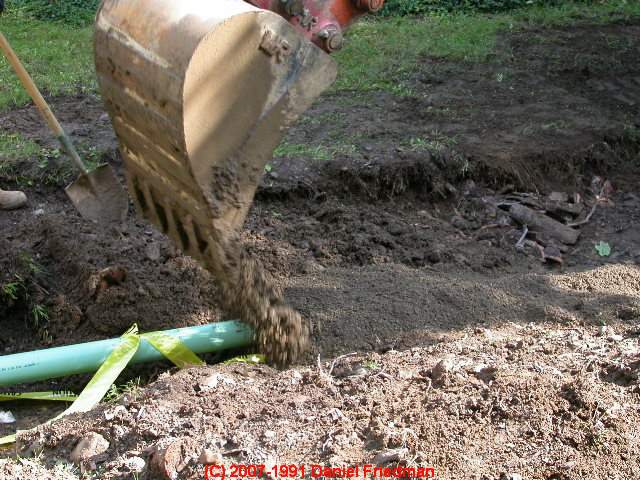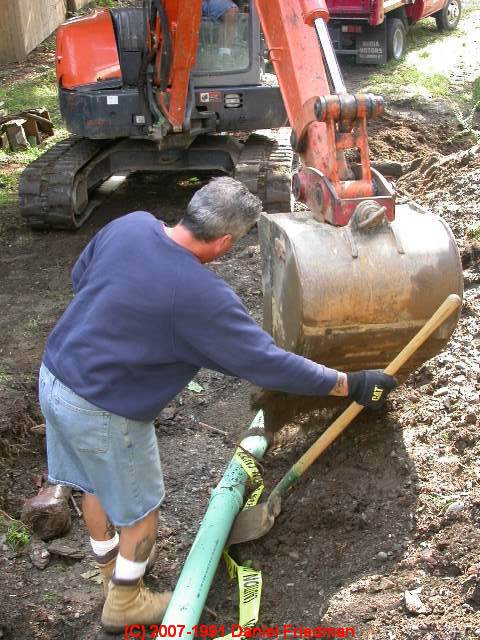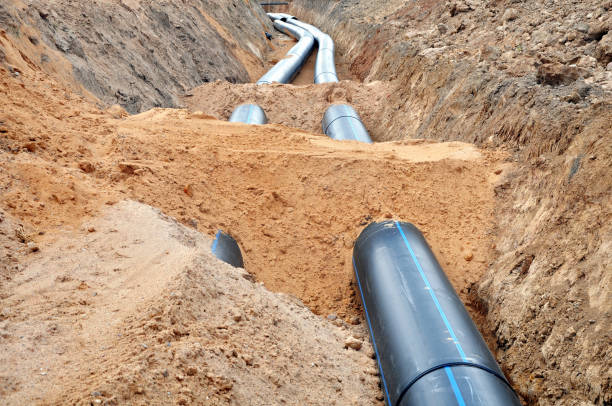If the pipe connection has a flaw or if the ground shifts a pipe crack could form. Bank run, lime dust, pea gravel are a few types they will accept.

Sewer Line Replacement Guide - The Need For Sand During Backfill
If the foundation is unsuitable, it must be removed to a minimum depth of 150 mm (6 in) and replaced with appropriate material.
Why put sand around underground pipes. Chamfer the pipe to avoid any leaks or failed air tests at the joint lubricate both connector and pipe push the connector onto the pipe lubricate the receiving connector and open end of pipe (also chamfered) Jeepnick new member messages 18 reaction score 0 points 0 location phoenix, az nov 30, 2011 #4 thank you for the detailed and helpful information! Plastic pipe work relies on the granular fill around it for structural support without it the pipe work will become deformed when under load, if the deformation is greater than 5% of the pipe diameter then the system has failed and would require renewal.
Most times there are voids underneath the pipe and grillage creates instant compaction. These are the 4 major reasons that steps have to be taken to prevent pipes from freezing that are buried underground: Pipe profiling equipment is used to scan a ring of light onto.
Sand compacts and retains moisture, therefore it does not drain as well as gravel. Chapter 2 type and distribution of soil the soil placed around a buried pipe must be: Sand the purpose of a french drain is to form a wick effect that will pull moisture from the surrounding soil and let it drain away from the area.
For the best results when filling that hole back in, make sure there's lots of sand around the water pipe, 6 top and bottom should do, then cover with dirt/earth. Pressure acting on underground pipes due to weight of soil and transport. Sufficient cover must be maintained to keep external stress levels below acceptable design stress.
As an added tip, wrapping pipe with plastic tape in this rising segment provides corrosion protection. Underground drainage is the general term given to the system of pipes and fittings that is installed below ground level to transport foul drainage or rainwater flows to a sewage treatment facility or, in the case of rainwater, a soakaway or water course. In my state, 6 of grillage is required.
Why do i need the extra drainage in gravel: If it doesn’t hold the pipe still against hydrostatic and hydrodynamic forces, you can get separation of joints and leakage from the pipes. The reasons why this technique is convenient are that it impacts minimally on the surrounding.
As a flexible, mobile substrate. The sand will allow for movement and the earth will provide the thermal protection. For these reasons many experienced contractors will avoid the use of gravels, sands, and ‘screening’ for pipe trench backfill.
If you get enough water in there to saturate the sand, and then keep adding water, it will help. An aggregate pipe bedding acts in two ways. We were particularly concerned for the durability of the new piping in this installation because there was not much backfill available to cover the piping where it had to pass over shallow bedrock.
If it stays completely dry, then silt/clay would be slightly better at 0.5 vs. The ‘how to’ of laying pipes for your underground drainage system can appear to be quite simple: The right type of soil 2.
Sand under and around a plastic sewer line protects it from breakage or penetration by sharp objects that may be nearby after backfill. The purpose of this procedure is to avoid leaving uncompacted soil underneath and beside the pipes. Doesn't matter what kind of pipe you use, it is still required.
The obvious benefit of using plastic pipe is the ease of use, with it being lighter in weight and being able to acquire longer runs of pipe therefore needing less connectors. 0.35, but this is rare. Relying on soil for restraint is essentially asking the soil to be as strong as the pipe material.
In firm, complete contact with the pipe foundation the foundation is the inplace material beneath the pipe. This is why the segment of a pipe entering the ground shows much greater corrosion than other areas. The system is a broad network of the underground pipes (rcc/cs).
Underground utility obstructions extensive underground utility obstructions can prevent a buried water service line. In recent years, directional drilling is becoming widely used for installing underground pipes, conduits, and cables with many different uses (gas transport, electric cables, water pipes, signaling, etc.). Where ledge rock, hardpan or boulders are encountered, it is necessary to pad the trench bottom using a maximum of four (4) inches of tamped earth or sand beneath the pipe as a cushion and for protection of the pipe from damage.
Still i don't like the depth of only 18 and if i were you i'd consider burying in deeper if possible. Typical underground piping over the past few years, the u nderground firewater piping has gained popularity because of the following: The network covers the whole refinery.
Uncompacted soil below or even on the same level as the pipes would compact over time and exert a bending moment on the pipes which could cause a break. Underground drainage plastic pipe 110mm. Plastic pipe runs can be ridged and not allow much flexibility.
Uncompacted soil above the pipes will eventually compact but will not stress the pipes. This keeps air away from a pipe. Flowable or ‘controlled density fill’ is often permitted and used to backfill certain trenches, and may even be required in some areas when the engineer is particularly concerned with settlement.
So, we rarely trust soil on its own to hold our pipelines together underground. Ordinary soils compact tight together this can exert pressure on the pipes and distort them, or cause joints to leak and as such any pipe should be laid and surrounded wi. Plastic pipe comes in 3m and 6m lengths.
Dunbar (ky) the use of sand or crushed stone is for compaction. Sand or stone dust/screenings is used when it is difficult to get good compaction around the loops and to protect the loops from any sharp rocks. If the pipe is backfilled directly with soil the.
The wastewater is brought here by the pipelines and through tankers. I used sand in my basement because i needed to try to compact it under a fairly tight network of pipe. Because the lower you travel underground, the soil generally becomes more tightly packed.

Examples Of Pipe Installation [8]: (A) Grade Light 2500 Utility... | Download Scientific Diagram

Repairing Process Of Underground Water Supply Pipeline. Black Plastic Tubes In Trench Of Sand Joined With Steel Pipes With Multi Joint Member And Screw Flange. Stock Photo, Picture And Royalty Free Image.
Water Pipes In Sand Repair Stock Photo - Download Image Now - Istock

Sewer Line Replacement Guide - The Need For Sand During Backfill
36,002 Sewer Pipe Stock Photos, Pictures & Royalty-Free Images - Istock

